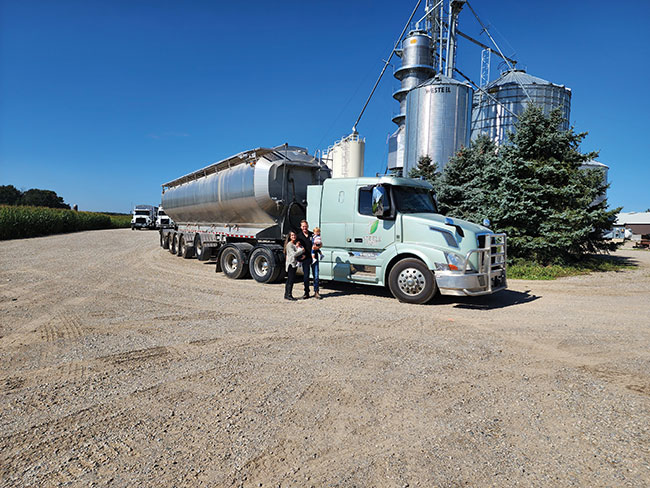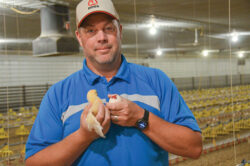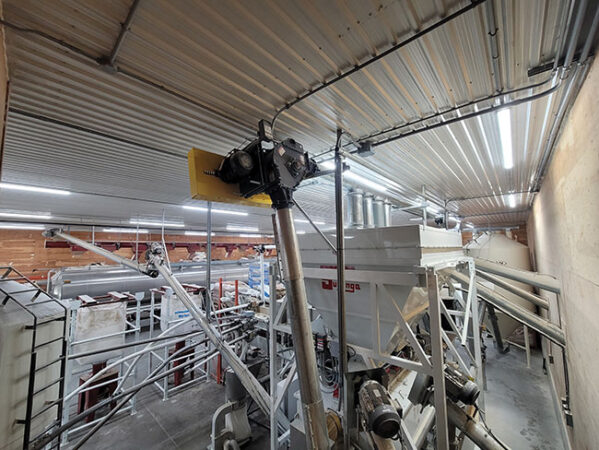
On-Farm Feed Mills: Advocates say they improve flock health and performance
By Treena Hein
Features Farm BusinessSome producers are opting to build on-farm feed mills for more control over bird health, performance and profits.
 Pictured is Matt Steele of Steele Hall Farm, a turkey operation, with his wife and children. The Steele family built a feed mill on their farm to gain more control over the cost and quality of their feed.
PHOTO CREDIT: Steele hall farm
Pictured is Matt Steele of Steele Hall Farm, a turkey operation, with his wife and children. The Steele family built a feed mill on their farm to gain more control over the cost and quality of their feed.
PHOTO CREDIT: Steele hall farm Although the number of on-farm feed mills on poultry farms in Canada isn’t easy to determine, it’s currently a substantial number and could be growing. The reasons for taking the plunge are similar among all farms – more control over feed to have more control over production (bird health, performance and profits).
Alberta broiler breeder producer Jeff Notenbomer, former chair of the Alberta Hatching Egg Producers and current director at the Canadian Poultry Research Council, has had an on-farm feed mill for over 25 years and it’s been a very positive experience overall.
Around 1996, Notenbomer decided he’d had enough of fighting feed consistency, both in volume and protein level. At his operation, Willow Creek Poultry in Lethbridge, he installed a mill for his 30,000 birds. He explains that “here in Alberta, it’s a wheat-based diet and differences in wheat protein level each year can be extreme. So, in addition to putting in our own feed mill around 1996, I started buying all our wheat for the year from one source and stored it. I made fresh feed for the layers every day and had excellent bird performance.”
But in 2019, difficulties emerged in sourcing micro-ingredients such as vitamins and amino acids. At times, Notenbomer was only able to buy lower-quality products, which represented a strong potential risk to flock health and more.
“I was getting nervous,” he remembers. “There was another issue as well. My feed is obviously mash, and I noticed there were more fines at the end of the row compared to the start of the row. It’s obviously really important with breeders, because they’re feed-restricted, that each bite for each bird has full nutrition. I wanted to solve that too.”
Notenbomer then decided to try feeding a blend of ground wheat with a purchased pellet. This strategy means that each bird gets a consistent bite and that Notenbomer still has control over protein level. He’s also still getting all or mostly all the savings an on-farm feed mill provides, compared to buying the total ration.
“We are getting consistent results, and I think it’s actually better results but it’s hard to compare exactly right now,” he explains. “Since the avian influenza outbreaks last year, we are doing longer production runs to ensure there are enough chicks due to a few breeder farms in the province having been wiped out.
“By the end of this year, those barns should be back to full production. Overall, I think I’m spending only a bit more, but I’m very happy with the results of this new blended feed.”
Since he put this strategy in place, Notenbomer has also been trying different levels of wheat, each of them over an entire year, and adjusting protein in the pellet accordingly. “I’m trying 20 per cent right now and I’m going to try 30 per cent for a year in November,” he says.
Disaster prompts change
The on-farm feed mill at Triaro Farms near Arthur, Ont., started up in November 2021. The farm is owned by Clarence Pronk and his sons Jason and Steve. There, they crop over 1,800 acres and produce almost a million broilers per year.

Alberta broiler breeder producer Jeff Notenbomer has had an on-farm feed mill for over 25 years.
A commercial-sized feed mill was always part of the farm business plan for several reasons. “We’d always thought about it, and we knew we could do better with bird performance with our own feed,” says Jason, “and we were done with zero control over price and sub-par feed quality. It’s been the best investment we’ve ever made in terms of profitability.”
Having an on-farm feed mill (in this case a roller mill to ensure a consistent grind size for the corn, and a Hayes & Stoltz mixer) would also provide an income stream through sales to other producers.
The push to finally order and install the mill came after a flock health disaster in early 2017 (bronchitis). “We were told it was all our fault, but turned out it was a hatchery problem,” Jason explains. “So, when we switched hatcheries, it was a great opportunity to try a new feed mill and compare that flock with another flock fed with feed we bought from a farmer who makes his own.
“We found bird performance was significantly better with the feed produced on farm, and so we went ahead with our own mill. Our feed conversion, mortalities and condemns are so much better and the barn conditions are too. The ammonia levels are lower, and litter is dryer, making the birds so much more comfortable.”
In Jason’s view, this is because the feed they make is closer to what chickens are created to eat, and because it’s better quality. He explains that their mash requires the birds’ gizzard to work, whereas commercial feed pellets do not, circumventing this natural digestive system component.
“The closer you get to nature, the better for the bird,” he says. “You do have to manage the birds differently, but it’s not a big deal. And in terms of quality, we don’t put in fillers or cheaper by-products, and we use high-quality vitamin and minerals as opposed to lower quality. So of course, the birds are healthier.
“We have ground corn, expeller soybean meal, hi-pro corn distillers and a high-quality premix that make up the bulk of our feed rations. Right now, we use all our corn to make feed for ourselves and a few customers, so if we expand, we’ll need to buy corn. We sell all our soybeans and buy meal, but we’re dreaming of our own on-farm soybean processing system.”
ROI was expected to be 10 years but Jason and his family think that with their feed sales, it will likely be reached in seven or eight years. They sell their feed at a price that’s at least that of commercial feed, usually, but that makes sense as the quality is so high. “We are not least-cost formulated and we are now selling almost as much feed to other farmers as we use,” he says. “We can make ten times as much feed as we are now, so we will expand. We tell other farmers who want to buy from us, you will not save money buying our feed, and if they made their own feed like we do they would save on that, but we tell them the money is made in the barn.
“The bird health, feed conversion and mortalities are all much better. It’s a no-brainer. And we also tell other farmers, size doesn’t matter. If you produce this many birds, put in a feed mill that fits your farm. It’s still worth time and money. I’ve heard that out west, it’s common to produce feed on the farm, but Ontario broiler producers are being told there is no money in it. That’s just not true.”

Pictured are ingredient scales, augers and conveyors, and a pre-grind corn system at Steele Hall Farm.
PHOTO CREDIT: Steele hall farm
Costs, research and pivoting
It was 2018 when the Steeles took the plunge into on-farm feed milling. Ron and Debbie Steele established Steele Hall Farm in southern Ontario in 1976, where the family produces turkey, chicken, grain and processing vegetables. Their sons Matt and John Steele are the next generation leading and growing the business, supported by their sister Julie Lyzenga, who is the farm’s health and nutrition specialist.
Similarly to others, Matt explains that “we decided to build an on farm mash mill in order to allow us to achieve complete control over our poultry diets and control more aspects of our production. Milling feed has reduced our total feed input expense by lowering our freight costs, utilizing grain from our elevator system, and continuously working to optimize ingredient value, as well as researching and utilizing innovative feed additives.”
Having their own feed and monitoring bird performance also means the Steeles “have the ability to make changes to our diets very quickly if a challenge related to nutrition is discovered,” says Matt. “It also allows us to react to our processing customers market demands such as Halal, grain-fed, raised without antibiotics, etc.”
At the beginning of feed mill operation five years ago, their flocks took a few days longer to reach market weight compared to commercial pellet feed, but they quickly narrowed that gap through collaborating with a nutritionist. In addition, Matt says “we recently added a pre-grind corn system along with an additional minor and major ingredient scale which has increased our production speed to 18MT per hour which works well for our operation, with growth in mind.”
Print this page